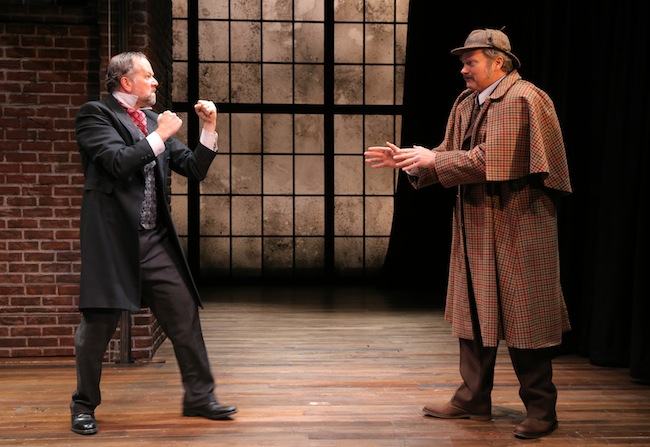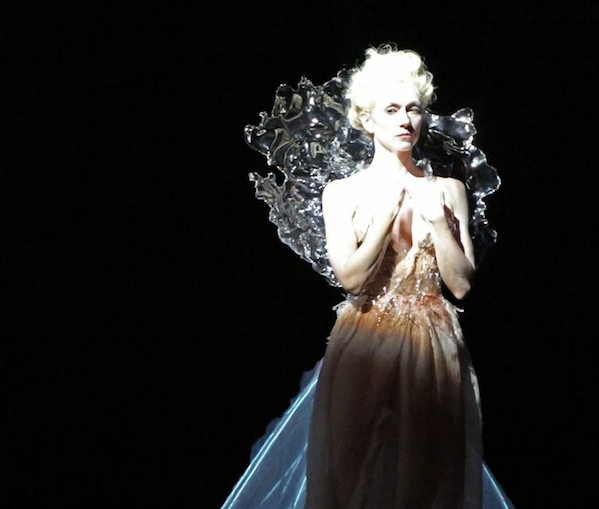Theater Review: A New York Stage Round-up — Too Much to See, Too Little Time
The gem of the weekend was an exhilarating production of “A Midsummer Night’s Dream,” directed by Julie Taymor in the extravagantly imaginative style she has developed over nearly three decades.
A Weekend of Theater in New York: After Midnight at the Brooks Atkinson Theatre; A Gentleman’s Guide to Love & Murder at the Walter Kerr Theatre; Julie Taymor’s A Midsummer Night’s Dream at Theatre for A New Audience, Brooklyn, NY, through January 12; and The (Curious Case of The) Watson Intelligence at Playwrights Horizons, through December 29.
By Iris Fanger
A mid-December weekend in New York presented so many tantalizing possibilities for dance, theater, and opera that I felt like a Pavlov’s dog bewildered by too many choices. Sometimes the availability of tickets – or not – made it easier because only so many shows could be packed into a few days, and/or the plays in repertory had performance schedules that didn’t sync with mine.
No matter. Even with so many theaters and so little time, a quartet of varied attractions fit into three days: the 1920s-30s Harlem revue, After Midnight; the picturesque Victoriana of A Gentleman’s Guide to Love and Murder, a Gilbert and Sullivan-like musical, though one that came off as if the esteemed 19th century composer and lyricist had based a plot on penny-dreadful novels; Julie Taymor’s visionary production of A Midsummer Night’s Dream, the opening production at the new Brooklyn home of Theatre For A New Audience; and the premiere of The (Curious Case of The) Watson Intelligence by Madeleine George at Playwrights Horizons on Theater Row, W. 42nd Street.
The gem of the weekend was A Midsummer Night’s Dream, directed by Taymor in the extravagantly imaginative style she has developed over nearly three decades, starting as far back as Liberty’s Taken at Castle Hill Festival in Ipswich, MA (1985) and moving onto The Lion King, which is still packing them in after 10 years on Broadway (plus two U.S. touring companies, and troupes in London, Sydney, Tokyo, and Hamburg). Let’s leave off dissing (any longer) the ill-fated Spiderman-Turn Off The Dark, and keep her films and opera stagings in mind. An abbreviated, family friendly adaptation of her production of The Magic Flute is currently a holiday attraction at The Metropolitan Opera—that makes three Taymor shows running this month in New York.
Taymor turned her back on Broadway for Dream. The new house gave her the freedom to escape the limits of the proscenium arch; she ranges far and wide in a black-box space. The audience is seated on three sides of the stage and stacked up on three levels. The stage floor is equipped with traps for surprise entrances and exits; beams overhead are fitted with ropes and pulleys to fly in actors and props. Movable screens billowed up and out for projections such as the huge, purple flower that Puck plucks for Oberon. The theatrical magic is generated by a mix of complex and the simple—a shining white bed sits in the middle of the stage as the audience filed in. The cast is made up of an assortment of actors, without prejudice to age, race or gender. The costumes come from varied periods: the court at Athens for Theseus and Hippolyta (the stunning Okwui Okpokwasili); the British music hall and silent film era for the production’s raffish Puck, who is played by Kathryn Hunter, an elfin clown, mime, actor, dancer and comedian. The foolish lovers could have been frat-boys and sorority girls on the giddiest of double-dates. The troupe of 20 children, dressed as street urchins rather than ballerina-skirted fairies, skitter round and about throughout the action, expanding the playing space. When the child-fairies are called on to fly, they are not dangled (conventionally) from ropes. Each is shadowed by an adult actor who hoist them up, dipping and bending them in the air. Elliot Goldenthal’s score is an evocative grouping of sounds and melodies, accenting rather than overwhelming the dramatic action.
The Rude Mechanicals, in modern dress, might be plumbers and carpenters working somewhere on your street. The motley crew is led by the hilarious Max Casella, who plays the over-zealous ham-actor Bottom. If you think you’ve seen too many productions of this often-staged Shakespearean comedy, reconsider. Taymor has given the work a visual poetry that is worthy of the playwright.
Two musicals that opened this fall on Broadway, After Midnight and A Gentleman’s Guide to Love and Murder, could not differ more in style and intent, but they share a high skill level on the part of the casts and creative personnel. After Midnight is a revue that evokes the nightclubs of Harlem in the 1920s-30s, when jazz was popularized through the song-writing and performing talent of the likes of Duke Ellington, Cab Calloway, and Harold Arlen. After Midnight has no storyline, but presents a fascinating suggestion of what life was like on and off the stages of such fabled establishments as the Cotton Club.
The moving bandstand for The Jazz At Lincoln Center All-Stars, directed by Wynton Marsalis, is at the center of the action, an obvious invitation to re-experience the Big Band era. A single street lamp is positioned down stage right. The acts follow one another without introduction. TV star Dule Hill (star of USA Network’s Psych) starts and ends the show with verses by Langston Hughes. The most colorful performers are the tappers: Dormeshia Sumbry-Edwards, Julius “Glide” Chisolm, Daniel Watts, and Phillip Attmore. Former Twyla Tharp dancer Karine Plantadit decorates the dance numbers. The sassy-mouthed Adrienne Lenox belts out two of the songs. The vaudeville-like piece that sticks in my mind is one for a quintet of men, marching in perfect unison, seemingly joined at the crease of their knees. They navigate the stage like The Rockettes in the fabled “March of the Wooden Soldiers” number. Dancer Desmond Richardson leads the ensemble in a contemporary ballet set to the music of “The Mooche” by Duke Ellington and Irving Mills. Guest star Fantasia Barrino, of American Idol fame and Broadway’s The Color Purple, fronted many of the songs.

David Costabile and John Ellison Conlee in The (Curious Case of The) Watson Intelligence. Photo: Joan Marcus.
A Gentleman’s Guide to Love and Murder, a Broadway musical based on the book that inspired the memorable Alec Guinness film Kind Hearts and Coronets keeps the source’s gimmick intact — one actor plays each of the unlucky members of the artistocratic D’Ysquith family. Jefferson Mays, a master of shape-changing, appears as the eight unfortunate relatives who stand in the way of Monty Navarro’s inheritance. Mays is a national treasure as an actor, filling the frenzied mayhem with humor, energy, and tenacious joie de vivre. It’s no small achievement that Bryce Pinkham, as Monty, is not acted off the stage by his chameleonic co-star. Additional kudos must go to the dressers in the wings who hustle Mays through ultra-quick costume changes that involve facial hair, wigs, bustles, and ridiculous hats. The music and lyrics by Steven Lutvak and Robert L. Freedman are as original as anything currently heard on Broadway, capped by a loving nod to Gilbert and Sullivan.
The trio of actors in The (Curious Case of The) Watson Intelligence at Playwrights Horizons have been handed an almost impossible task by dramatist Madeleine George. She has exploited the coincidence of the name Watson, as in Sherlock’s Holmes’ side-kick and the man whom Alexander Bell called on that fateful night when he proved that sound could travel though a wire. She has set both Watsons on stage in a series of convoluted time-travel scenes that make no sense in relationship to each other until well into the second act. George seems to be exploring several themes: one is about how we are all connected (“People who need people,” etc), another is about the importance of the not-so-famous person who only stands and waits to serve history. John Ellison Conlee plays the several Watsons, including a robot being developed by Amanda Quaid as a scientist (don’t ask), with David Costabile as the ever-angry other man. The actors deserve a collective purple heart for courage in tackling this convoluted script.
The shows I missed included Mark Rylance in Twelfth Night, (and Richard III) and the Brit team of Ian McKellen and Patrick Stewart in Waiting for Godot and No Man’s Land. I tried for timed tickets to the Vermeer exhibit at the Frick Museum, but they were sold out a week in advance. I could have extended the trip for four days and there would have been no scarcity of wondrous sights to behold.
Iris Fanger is a theater and dance critic based in Boston. She has written reviews and feature articles for the Boston Herald, Boston Phoenix, Christian Science Monitor, New York Times, and Patriot Ledger as well as for Dance Magazine and Dancing Times (London).
Former director of the Harvard Summer Dance Center, 1977-1995, she has taught at Lesley Graduate School and Tufts University, as well as Harvard and M.I.T. She received the 2005 Dance Champion Award from the Boston Dance Alliance and in 2008, the Outstanding Career Achievement Award from the Graduate School of Arts and Sciences at Tufts. She lectures widely on dance and theater history.
Tagged: A Gentleman’s Guide to Love & Murder, A Midsummer Night's Dream, After Midnight, Julie Taymor


